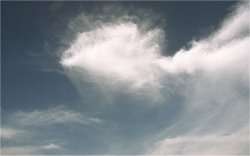Studying ice crystals to understand the cloud-climate connection

(PhysOrg.com) -- Beginning in mid-December, scientists will undertake a special mission to squeeze the secrets out of ice crystals in cirrus clouds. The SPARTICUS, or Small Particles in Cirrus, campaign will weave together data from an instrumented airplane and ground-based instruments to gather the most comprehensive set of ice crystal measurements yet. Scientists from Pacific Northwest National Laboratory are part of the team that will define the scientific mission and they are leading the project's daily operations.
Ice crystals reflect a portion of the solar energy that reaches the Earth, and absorb energy emitted by the Earth, making cirrus clouds the only cloud type that warms the atmosphere. So accurate information about crystal shape and size will contribute to improving our understanding of the effects of clouds in a warming climate. Past measurements have been inaccurate because the shape of aircraft probes had a shattering effect on ice crystals, resulting in a disproportionate amount of small particles being measured. One of the main objectives of SPARTICUS is to ascertain the abilities of new probes that could minimize the shattering effect.
"Improved characterization of the instruments means we'll have more accurate data on the number of ice crystals in cirrus clouds, and how much solar energy is being absorbed and reflected by these clouds," said Dr. Jennifer Comstock, a PNNL atmospheric scientist who helps direct the science behind the project. "We need to nail down the impacts of clouds and cloud properties to develop better models for helping to understand the climate system and predict the impact of future climates on society."
Research flights start in December 2009 and continue through April 2010. The SPARTICUS aircraft will take samples above the Department of Energy's Atmospheric Radiation Measurement (ARM) Climate Research Facility's Southern Great Plains site in Oklahoma. Some flights will be timed to correspond with satellite overpasses for additional comparative measurements. Data will be sent to the ARM archive where it will be accessible to scientists.
PNNL scientists Drs. Xiaohong Liu and Jennifer Comstock are part of the team defining the science mission of SPARTICUS. PNNL's Dr. Beat Schmid is technical director for the DOE ARM Aerial Facility (AAF). Jason Tomlinson (PNNL) and Jennifer Comstock are AAF operations leads and will direct the project's daily operations. Dr. Chaomei Lo and Sherman Beus are assisting with software applications and programming to assess data quality. Dr. Jay Mace, from the University of Utah, is leading the SPARTICUS project.
Data from SPARTICUS will allow scientists to move forward with greater confidence in answering questions about how much the smallest ice crystals contribute to reflecting solar energy from cirrus clouds, and types of physical processes that influence the life cycle of cirrus clouds. The information gathered on the SPARTICUS mission will also help scientists improve problem-solving procedures, or algorithms, that allow them to derive cloud properties using ground-based instruments. These improved properties will provide valuable information for evaluating and improving climate models.
More information: acrf-campaign.arm.gov/sparticus/
Provided by Pacific Northwest National Laboratory (news : web)















